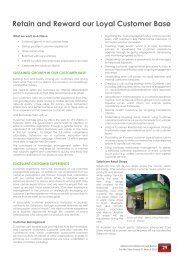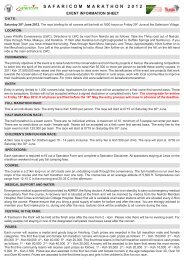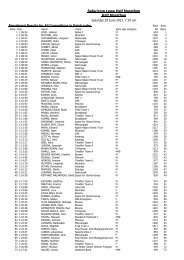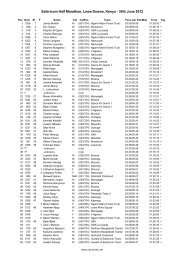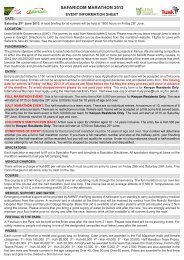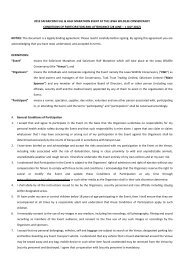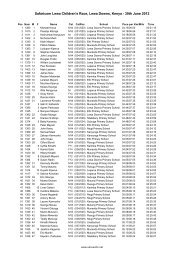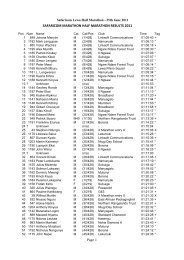Sustainability Performance: At a glance (31 March 2012) - Safaricom
Sustainability Performance: At a glance (31 March 2012) - Safaricom
Sustainability Performance: At a glance (31 March 2012) - Safaricom
Create successful ePaper yourself
Turn your PDF publications into a flip-book with our unique Google optimized e-Paper software.
Global Reporting Initiative Compliance Table<br />
GRI Section Description<br />
Reference<br />
3.7<br />
3.8<br />
3.10<br />
3.11<br />
3.12<br />
4.1<br />
4.2<br />
State any specific limitations on the scope or<br />
boundary of the report.<br />
Basis for reporting on joint ventures,<br />
subsidiaries, leased facilities, outsourced<br />
operations, and other entities that can<br />
significantly affect comparability from period to<br />
period and/or between organisations.<br />
Explanation of the effect of any re-statements of<br />
information provided in earlier reports, and the<br />
reasons for such re-statement (e.g., mergers/<br />
acquisitions, change of base years/periods,<br />
nature of business, measurement methods).<br />
Significant changes from previous reporting<br />
periods in the scope, boundary, or<br />
measurement methods applied in the report.<br />
Table identifying the location of the Standard<br />
Disclosures in the report. Identify the page<br />
numbers or web links where the following can<br />
be found:<br />
• Strategy and Analysis 1.1 – 1.2;<br />
• Organisational Profile 2.1 – 2.10;<br />
• Report Parameters 3.1 – 3.13;<br />
• Governance, Commitments, and<br />
Engagement 4.1 – 4.17;<br />
• Core <strong>Performance</strong> Indicators;<br />
• Any GRI Additional Indicators that were<br />
included; and<br />
Governance structure of the organisation,<br />
including committees under the highest<br />
governance body responsible for specific<br />
tasks, such as setting strategy or organizational<br />
oversight.<br />
Indicate whether the Chair of the highest<br />
governance body is also an executive<br />
officer (and, if so, their function within the<br />
organisation’s management and the reasons<br />
for this arrangement).<br />
About this report<br />
Not applicable<br />
to <strong>Safaricom</strong><br />
Not applicable<br />
to <strong>Safaricom</strong><br />
Not applicable<br />
to <strong>Safaricom</strong><br />
Refer to GRI<br />
table<br />
About<br />
<strong>Safaricom</strong><br />
Governance<br />
About<br />
<strong>Safaricom</strong><br />
Governance<br />
Page number (s)<br />
Page 6<br />
Not applicable<br />
Not applicable<br />
Not applicable<br />
Page 114 - 118<br />
Page 37 - 38<br />
Page 37<br />
GRI Section Description<br />
Reference<br />
For organisations that have a unitary board<br />
structure, state the number and gender of<br />
members of the highest governance body<br />
that are independent and/ or non-executive<br />
members.<br />
Mechanisms for shareholders and employees<br />
to provide recommendations or direction to<br />
the highest governance body.<br />
Include reference to processes regarding:<br />
• The use of shareholder resolutions or<br />
other mechanisms for enabling minority<br />
shareholders to express opinions to the<br />
highest governance body; and<br />
• Informing and consulting employees<br />
about the working relationships with<br />
formal representation bodies such as<br />
organisation level ‘work councils’, and<br />
representation of employees in the<br />
highest governance body.<br />
Identify topics related to economic,<br />
environmental, and social performance<br />
raised through these mechanisms during the<br />
reporting period.<br />
List of stakeholder groups engaged by the<br />
organisation.<br />
Examples of stakeholder groups are:<br />
• Civil society;<br />
• Customers;<br />
• Local Communities;<br />
• Shareholders and providers of capital;<br />
• Suppliers; and<br />
• Employees, other workers, and their<br />
trade unions.<br />
Basis for identification and selection of<br />
stakeholders with whom to engage.<br />
About <strong>Safaricom</strong><br />
Governance<br />
About <strong>Safaricom</strong><br />
Governance<br />
116 <strong>Safaricom</strong> <strong>Sustainability</strong> Report <strong>2012</strong> <strong>Safaricom</strong> <strong>Sustainability</strong> Report <strong>2012</strong> 117<br />
4.3<br />
4.4<br />
4.14<br />
4.15<br />
Global Reporting Initiative Compliance Table<br />
Employee<br />
Environment<br />
About <strong>Safaricom</strong><br />
Our stakeholders<br />
* Each performance<br />
section details<br />
the relevant<br />
stakeholders and<br />
how we engage<br />
with them<br />
About <strong>Safaricom</strong><br />
Our stakeholders<br />
Page number (s)<br />
Page 37<br />
Page 38; Page 88<br />
Page 38 - 43<br />
Page 39



